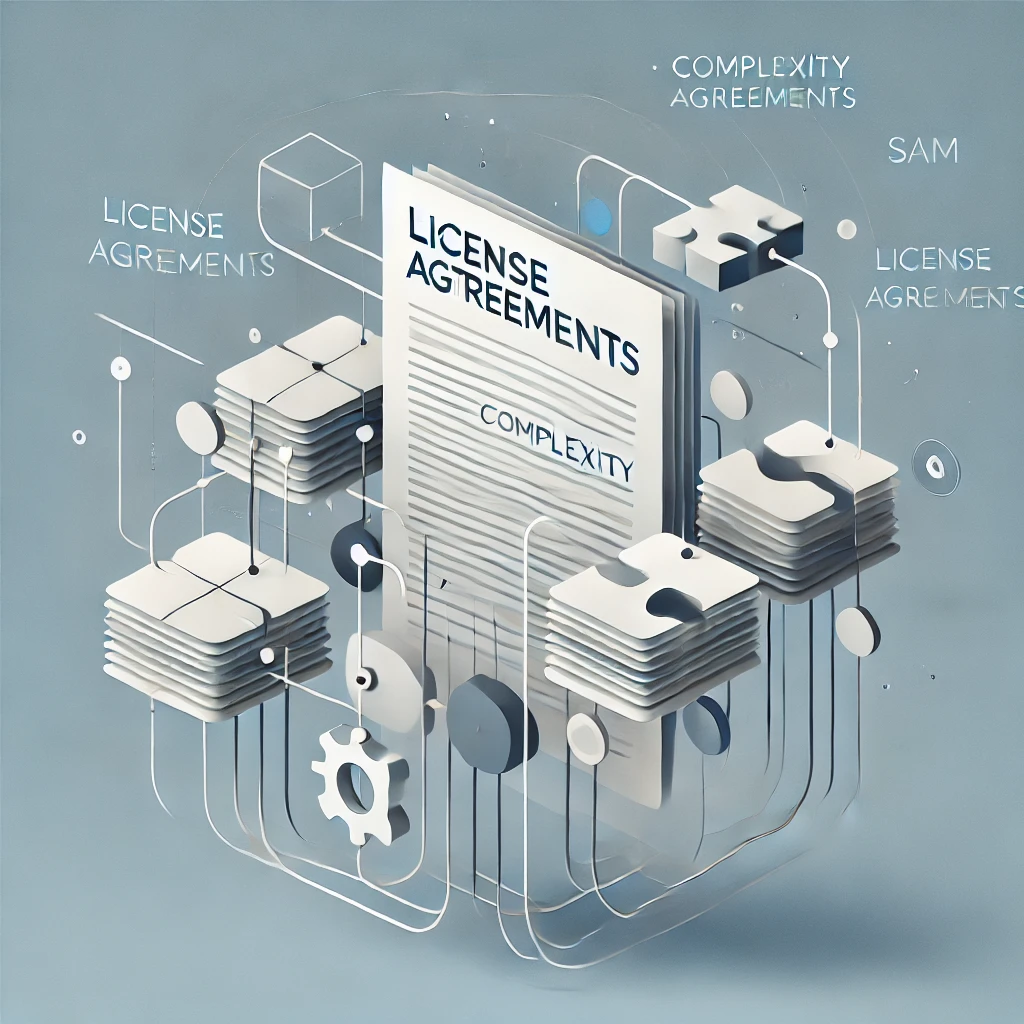Challenges in Software Enterprise License Management
- Compliance: Ensuring adherence to licensing terms
- Cost control: Managing expenses while avoiding over-licensing
- Audits: Navigating vendor audits and preventing penalties
- Complexity: Managing diverse software environments and licenses
- Tracking: Maintaining accurate records across multiple devices
- Optimization: Aligning licenses with actual usage
- Renewals: Handling subscription and contract renewals
Challenges in Software Enterprise License Management
Managing software licenses has become a critical yet complex task in the ever-evolving landscape of enterprise technology.
As organizations adopt an increasing number of software solutions on-premises and in the cloud, software enterprise license management (ELM) has become increasingly important for controlling costs, ensuring compliance, and maximizing the value derived from technology investments.
However, software license management presents numerous challenges, and organizations often find themselves overwhelmed by the intricacies involved.
Understanding and overcoming these challenges is crucial to maintaining operational efficiency and minimizing the risk of financial and legal penalties.
The Complexity of License Agreements

One of the primary challenges in software enterprise license management lies in the complexity of licensing agreements. These agreements often contain intricate terms, conditions, and clauses that can be difficult to interpret.
Navigating them can be daunting, especially for organizations with multiple vendors, each with its licensing requirements.
Multiple Versions of Licensing Documents
Enterprise software vendors frequently issue multiple versions of their licensing agreements over time. Each new version may introduce subtle changes to terms and conditions or alter the underlying licensing structure.
When organizations purchase software over an extended period, they may hold several versions of licensing documents, each with slightly different terms. This makes it difficult to determine which version applies to a specific deployment, leading to confusion and potential compliance issues.
Vendor-Specific Terms and Conditions
Furthermore, dealing with multiple vendors can amplify the complexity of license management. Each software vendor typically has unique licensing terms, which may vary based on product type, deployment model, and user count.
For example, a SaaS vendor may offer a subscription-based pricing model, while an on-premises software vendor might offer a perpetual license model. Understanding the implications of each licensing structure and how they apply to the organization’s specific needs requires expertise and careful attention to detail.
Specialized Knowledge for Interpretation
The complexity of license agreements also means that organizations often need specialized knowledge to interpret terms correctly. Legal teams, software asset managers, and procurement officers must understand licensing terminology to avoid misinterpretations. Without this expertise, companies risk purchasing unnecessary licenses, violating terms, or being caught unaware during software audits.
Usage Tracking and Compliance Challenges

Another significant challenge in software license management is tracking software usage and ensuring compliance with the licensing agreements. This is particularly difficult in large organizations, where different departments, locations, and user types may require varying levels of software access.
Monitoring Software Usage
Organizations often struggle to maintain accurate records of who uses what software and whether that usage complies with the licensing terms. This becomes even more difficult when employees use different devices (laptops, desktops, mobile devices) or work remotely.
The rise of remote work and hybrid work environments further complicates this, as software usage is no longer confined to a centralized office location where it is easier to track.
Without comprehensive tracking mechanisms, organizations may fail to identify instances of underutilized licenses, software not being used as intended, or employees using more licenses than they are entitled to.
This lack of oversight can result in overspending on licenses or violating licensing terms, leading to significant financial and reputational risks.
Compliance Risks and Audits
License compliance is another area where organizations face significant risks. Without proper management, companies can inadvertently violate the terms of their software licenses, leading to several potential consequences:
- Legal Penalties and Fines: Non-compliance can result in legal action from vendors, which may involve hefty fines or forced payments for back-licensing.
- Reputational Damage: Legal violations and software audits that reveal non-compliance can damage an organization’s reputation, undermining trust with customers, partners, and investors.
- Unexpected Costs: If a vendor performs a software audit and discovers underreporting or unlicensed usage, the company may be required to pay for additional licenses, sometimes at inflated rates. These unexpected costs can strain budgets and derail financial plans.
Financial Impact and Resource Allocation

Managing software licenses efficiently can be a major driver of cost savings, while poor license management often leads to unnecessary overspending. Organizations often face the problem of over-purchasing and under-utilizing software licenses, which can have a significant financial impact.
License Overspending
One of the most common issues in software license management is license overspending. This occurs when companies purchase more licenses than they need, often because of uncertainty around future needs or simply to meet minimum purchase requirements for discounts.
In other cases, organizations may purchase licenses based on projections of demand that never materialize, leading to unused or underutilized software licenses.
Another form of overspending occurs when departments or business units independently purchase redundant software subscriptions. With no centralized oversight, it is common for different teams to buy similar tools or applications without realizing that a more cost-effective solution already exists in the organization’s portfolio. These duplicate subscriptions result in wasted spending and missed opportunities for consolidation.
Resource Optimization
A key aspect of license management is optimizing resources across the organization. It’s common for businesses to manage numerous software solutions without fully understanding how they are used across different departments.
The average organization maintains around 130 different SaaS subscriptions, which can be difficult to track and optimize.
This lack of central oversight leads to:
- Duplicate Subscriptions: Multiple teams may purchase the same or similar tools, unaware that other teams have already subscribed to the same software, resulting in unnecessary duplication.
- Underutilized Licenses: Not fully used licenses lead to waste, especially when software remains installed or available but isn’t actively used by employees.
- Inefficient Budget Allocation: Without a centralized system for managing licenses, organizations may allocate their IT budgets inefficiently, paying for unnecessary software or failing to negotiate better pricing and licensing terms.
Technical Environment Complexities

The increasing complexity of IT environments, particularly with the rise of virtualization and cloud technologies, presents additional challenges for license management. As organizations adopt new technologies, the dynamics of license management evolve.
Virtualization Challenges
Virtualization, whether on-premises or in the cloud, has become a standard in many enterprises. However, managing licenses in a virtualized environment presents unique challenges.
For instance:
- License Usage Across Virtual Instances: Virtualized environments allow multiple instances of a single application to run on a single physical server. Managing these instances can be tricky, as many traditional license models are based on physical devices rather than virtual instances.
- Dynamic Workloads: Cloud environments are dynamic, with resources allocated and reallocated based on fluctuating demands. As workloads shift, license requirements can also change, making tracking usage in real-time difficult.
- Complex Licensing Models: Some software vendors apply complex licensing models specific to virtualized environments, making it more challenging to determine the appropriate licensing needs.
Integration Issues
Another technical challenge is managing licenses across different systems and platforms, especially when integrating multiple software applications through APIs or automated provisioning systems.
Organizations must ensure that software usage is tracked consistently across environments, which requires careful planning and investment in the right tools to manage and monitor these systems effectively.
Best Practices and Solutions for License Management

Given the numerous challenges in software license management, organizations need to adopt best practices and implement solutions that streamline the process and reduce risks.
Centralized License Management
Implementing a centralized approach to software license management is crucial. This involves creating a comprehensive software inventory, maintaining detailed records of all licenses, and tracking expenses and usage patterns. Centralized management ensures that businesses have a clear view of their software assets and can more easily identify opportunities for optimization.
Automated Solutions
Automation can significantly improve the efficiency of license management. Implementing specialized license management software can automate routine tasks such as tracking usage, alerting managers to upcoming renewals, and monitoring compliance. These systems can also generate reports that provide insights into license usage across different departments and business units, helping to ensure better decision-making.
Employee Training and Awareness
Proper employee training is vital for successful license management. Educating employees about compliance requirements, usage policies, and the financial implications of improper license management ensures that everyone within the organization is aligned and aware of their responsibilities.
Strategic Planning and Process Documentation
Organizations should develop a strategic approach to license management, including regular audits, proactive renewal management, and continuous optimization of license allocation. Documenting procurement procedures, usage guidelines, and roles and responsibilities ensures consistency and reduces the risk of errors.
Future Considerations
As organizations evolve, so too must their approach to license management. This requires:
- Hybrid Licensing Strategies: As cloud services increasingly replace traditional on-premises solutions, organizations must develop strategies for both cloud and on-premises licenses.
- Scalability Planning: As businesses grow, their licensing needs will change. Organizations should plan for future scalability, considering how to manage licenses as the number of users, devices, and systems increases.
FAQ: Challenges in Software Enterprise License Management
What is software license management?
Software license management refers to managing and controlling software licenses within an organization to ensure compliance, minimize costs, and avoid legal risks.
Why is license management important for enterprises?
Effective license management helps businesses ensure compliance, avoid unnecessary expenses, and mitigate legal and audit risks.
What challenges arise in managing software licenses?
Common challenges include compliance risks, difficulty tracking usage, managing costs, and staying on top of renewals and audits.
How do software audits impact organizations?
Audits can lead to penalties if a company is out of compliance, often requiring time and resources to resolve licensing issues.
What tools are available for software license management?
Many software asset management (SAM) tools, such as Flexera, ServiceNow, and Snow Software, help track, manage, and optimize licenses.
How do organizations ensure compliance with software licenses?
Compliance is achieved through accurate tracking, proper documentation, regular audits, and alignment of software usage with license terms.
What are the consequences of failing to manage software licenses?
Failing to manage licenses can lead to financial penalties, legal risks, and loss of vendor trust.
How can companies reduce software licensing costs?
Organizations can reduce costs by accurately tracking software usage, avoiding over-licensing, and negotiating better terms with vendors.
What is the role of software asset management (SAM)?
SAM tools help manage software inventory, track usage, ensure compliance, and optimize software license utilization.
How can companies optimize their software licenses?
Optimization involves matching licenses with actual usage, eliminating unused licenses, and consolidating redundant software.
How can enterprises manage renewals effectively?
Tracking renewal dates and evaluating usage before renewals help ensure organizations only renew licenses they need.
What should enterprises consider when negotiating software contracts?
Enterprises should evaluate their current and future needs, licensing models, and growth potential when negotiating contracts to avoid overpaying.
How does cloud-based software impact license management?
Cloud software introduces flexibility but requires new strategies for managing subscriptions, monitoring usage, and controlling costs.
What are common mistakes in license management?
Over-purchasing licenses, neglecting audits, or failing to track usage are common mistakes that lead to compliance risks and unnecessary costs.
How do companies stay up-to-date with changing software regulations?
Monitoring vendor announcements, subscribing to relevant newsletters, and using software management tools help stay informed about licensing changes.